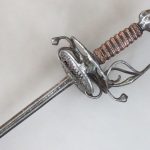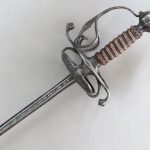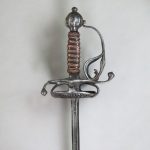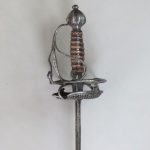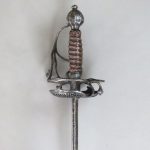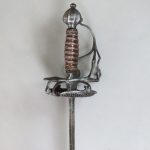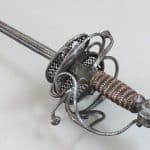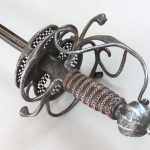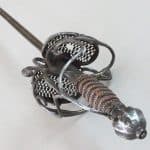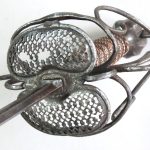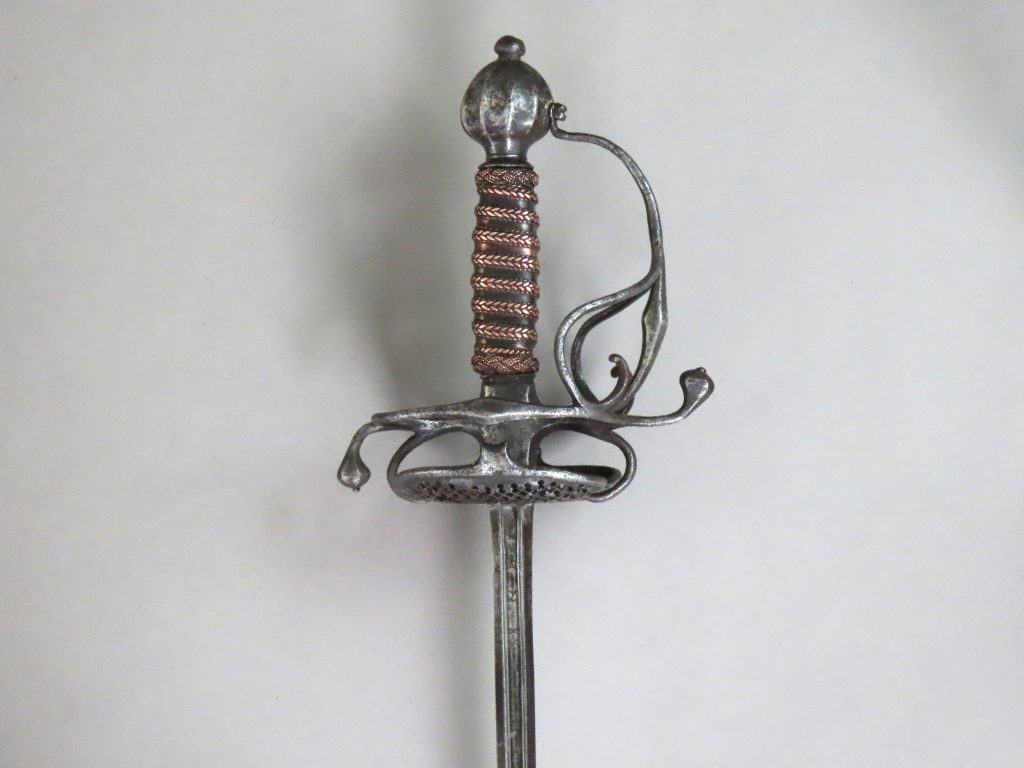
A Rare English Walloon Rapier dating to circa 1650 mounted with a Toledo Blade
To enquire about this itemplease click here
Price: £3,250
Ref: 42501806
Item Description
An attractive English rapier dating to the middle of the 17th century and the English Civil War period. The hilt is of typical English construction mounted with a double shell guard plate pierced in the Walloon fashion. The stiff slender Toledo blade is of fine quality. The rapier is in good original condition with a consistent blackened russet patination.
The hilt is of a high standard comprised of well executed slender six sided faceted bars rounded at the edges which give a smoothly contoured, elegant and well balanced appearance to the hilt. The boldly formed block has a rear quillon which curls downwards towards its swollen knopped and nippled terminal. A quillon to the front of similar shape is upwardly turned. Nearer to the block the knucklebow emanates from the front quillon and curls upwards into a flattened and angled terminal at the top where it is secured to the pommel with a square headed screw. Towards the bottom the bow is swollen in a diamond shape. Two symmetrical side rings emanate from the quillons near the block which are also swollen in the middle in the same manner. Two curved bars extend downwards from just below the knucklebow swelling and terminate in scrolls forged onto the side rings to strengthen the hilt structure in the English manner.
The floor of the guard is formed with two symmetrical conjoined oval shell guards, each with a thickened rim and upwardly curled crescent in the middle turned inwards towards the quillon block. The insides of the shells consist of two thin plates pierced with delicate conjoined circle and diamond shapes. One plate has been punctured twice. The damage appears to have been caused by the tip of the blade of an opponent. Underneath the cross guard, two outwardly convex finger rings, or pas d’ane rings, emanate from the hilt front and back and terminate between the shell guards at the flat floor of the guard.
The pommel is of solid onion shape with an integral raised button on top and a waisted neck beneath and shaped with ten hollow ground sides. The baluster shaped grip is of rounded rectangular section. It is spirally bound with copper strip, separated by contra-twisted ropes with narrower ropes on each side, also of copper. Copper woven ropes form “Turk’s Heads” top and bottom.
The slightly flattened diamond section blade is 34.5 inches (88 cm) long and of stiff construction designed mainly for thrusting. It has a short ricasso and a pronounced deep fuller on each side extending for 6.5 inches from the hilt, the ridges incised with lines, and punctuated with rows of dots, which converge on an incised cross shape beyond the fuller terminals.
Inside the fuller on each side in stylised capitals is a pair of “X” shapes followed by “EN”, then further “X” shapes followed by “TOLEDO” then a final pair of “X” shapes. Clearly the blade was made in Toledo. The crest of the maker was probably applied to the tang base which is obscured by the quillon block in this type of hilt.
English Walloon hilted swords are not common and English Walloon hilted rapiers are rarer still. Much individualism was exercised by the various hilt makers which led to a variety of expression within the parameters of the overall hilt design. For an example similar to our rapier see Stuart C Mowbray, “British Military Swords Volume One: 1600 to 1660”, Mowbray Publishing, 2013, page 272 and two further related examples on pages 273 and 274.


